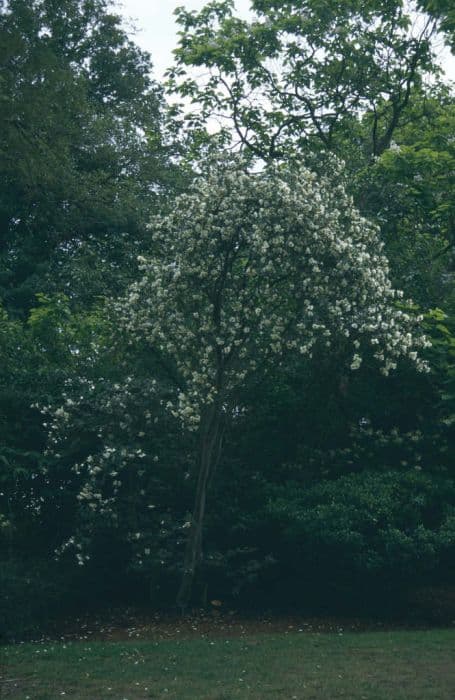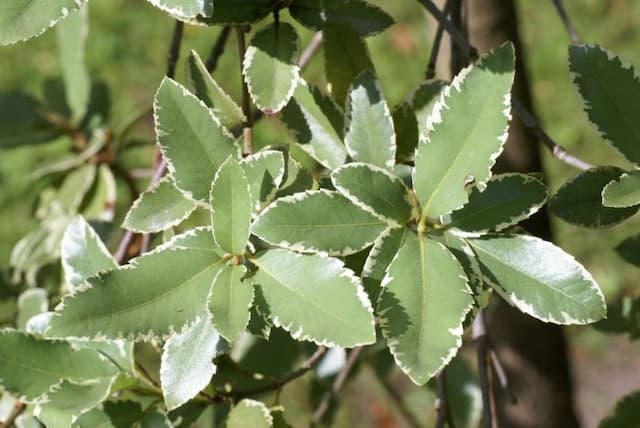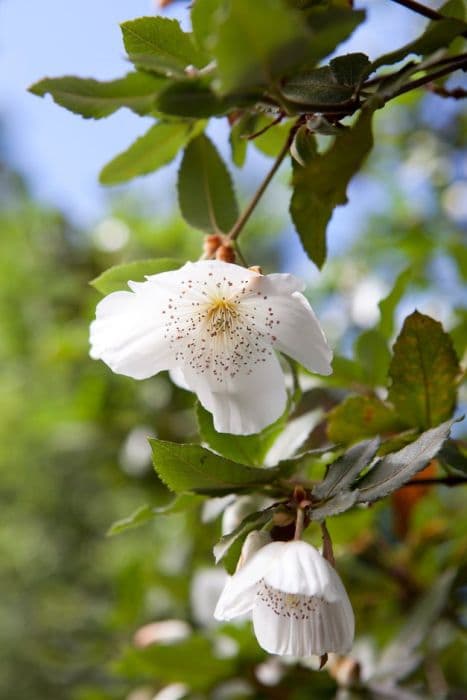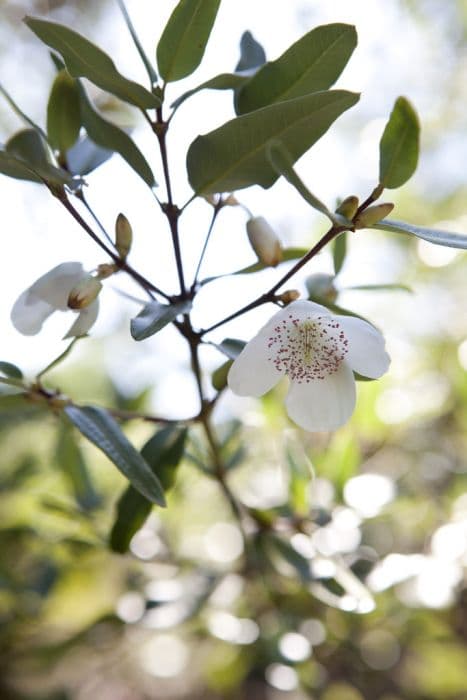Leatherwood Eucryphia × intermedia

ABOUT
Eucryphia × intermedia, commonly known as 'Eucryphia', is a hybrid ornamental plant that boasts a number of visually striking features. The plant typically displays a lush, dense growth habit, with rich green leaves that offer a glossy texture. The foliage outlines the shape of the plant, providing a vibrant backdrop for its standout flowers. The flowers of the Eucryphia are particularly notable for their aesthetic appeal, often described as large and showy. These blossoms are usually white, which contrasts beautifully against the dark green leaves, creating a dramatic visual effect that can be quite eye-catching in a garden setting. The petals are generally broad and arranged in a cup or rosette shape, encompassing a cluster of prominent stamens at the center, often with a golden or yellowish hue that adds to the plant's allure. Additionally, these flowers are known for their delicate fragrance, which can be quite attractive to both people and pollinators alike, such as bees and butterflies. The flowering period of the Eucryphia tends to be during the later part of the summer, when the plant can become a focal point in the landscape. Overall, the Eucryphia combines its strikingly glossy foliage with the elegant beauty and scent of its blooms, making it a well-regarded choice for gardeners looking to add a touch of elegance to their green spaces.
About this plant
 Names
NamesFamily
Cunoniaceae
Synonyms
Leatherwood, Eucryphia
Common names
Eucryphia × intermedia
 Toxicity
ToxicityTo humans
Eucryphia × intermedia, commonly known as Leatherwood, is not widely known to be toxic to humans. There is limited information available on the toxicity of this specific hybrid plant, and it doesn't appear on major toxic plant databases. Therefore, it's generally considered that Leatherwood does not pose significant risks of poisoning to humans when touched or ingested in small amounts. However, it's always advisable to exercise caution and avoid eating parts of ornamental plants unless they are known to be safe and edible.
To pets
Leatherwood (Eucryphia × intermedia) does not have a well-documented history of being toxic to pets. There isn't substantial evidence to suggest that this plant is harmful if ingested by animals such as dogs or cats. Nonetheless, it is prudent to prevent pets from consuming non-food plants as a general safety measure, since individual animals might have specific sensitivities or allergic reactions that aren't widely known or documented. If a pet does ingest Leatherwood and shows any signs of distress or illness, it is wise to consult a veterinarian.
 Characteristics
CharacteristicsLife cycle
Perennials
Foliage type
Evergreen
Color of leaves
Green
Flower color
White
Height
20 feet [6 meters
Spread
12 feet [3.7 meters
Plant type
Tree
Hardiness zones
9
Native area
Australia Tasmania
Benefits
 General Benefits
General Benefits- Ornamental Value: Eucryphia × intermedia, commonly known as Eucryphia, is prized for its attractive flowers, which enhance the aesthetic appeal of gardens and landscapes.
- Habitat Support: Provides food and habitat for a variety of insects, birds, and wildlife due to its flowers and structure.
- Shade Provision: The plant can grow into a sizeable tree or shrub, offering considerable shade in gardens and parks.
- Seasonal Interest: Offers a display of seasonal change with its flowers, which typically bloom in late summer, adding beauty to gardens throughout the growing season.
- Privacy Screen: When planted in a row or as a hedge, Eucryphia can serve as a natural privacy screen, due to its dense foliage.
- Windbreak: Larger examples of the plant can act as a windbreak, protecting other plants and outdoor areas from strong winds.
- Erosion Control: Its root system can help in stabilizing the soil, thereby reducing erosion on slopes or in areas prone to soil degradation.
 Medical Properties
Medical PropertiesThis plant is not used for medical purposes.
 Air-purifying Qualities
Air-purifying QualitiesThis plant is not specifically known for air purifying qualities.
 Other Uses
Other Uses- Eucryphia × intermedia, commonly known as Leatherwood, has been used in the production of honey, where bees are attracted to its flowers, leading to a distinctively flavored honey that is prized in some regions.
- The wood of Leatherwood is fine-grained and can be used for crafting small wooden objects, such as inlays and precision instruments where detail is essential.
- The bark of the Leatherwood tree can serve as a natural dye, offering a range of earthy tones for textiles and crafts.
- Due to its dense growth habit, Leatherwood can be employed as a windbreak in garden landscapes, providing protection for more delicate plants.
- Leatherwood's fragrant flowers could potentially be used in the making of perfumes and scents, although this is not a common commercial practice.
- The plant can be used for educational purposes, such as helping students learn about plant hybridization and pollination due to its status as a hybrid species.
- Its evergreen foliage and striking flowers make Leatherwood an ideal candidate for ornamental topiary in formal gardens.
- The dense canopy of Leatherwood provides habitat for birds and other wildlife, making it a valuable plant for biodiversity in garden design.
- In areas where Leatherwood is native, its flowers can be utilized in the celebration of local floral festivals, highlighting the region's natural beauty.
- For artistic purposes, the Leatherwood's elegant form and flowers can be the subject of botanical illustration and photography.
Interesting Facts
 Feng Shui
Feng ShuiThe Leatherwood is not used in Feng Shui practice.
 Zodiac Sign Compitability
Zodiac Sign CompitabilityThe Leatherwood is not used in astrology practice.
 Plant Symbolism
Plant Symbolism- Resilience: Eucryphia × intermedia, commonly known as Leatherwood, often symbolizes resilience due to its robust nature and ability to withstand challenging conditions.
- Purity: The white flowers of Leatherwood can represent purity and innocence, echoing its pristine and untouched habitat.
- Adaptability: Leatherwood's ability to thrive in various environments makes it a symbol of adaptability and versatility.
- Beauty: With its attractive flowers, Leatherwood is often associated with natural beauty and the appreciation of aesthetic pleasures.
 Water
WaterLeatherwood should be watered deeply but infrequently, ensuring the soil is moist but well-drained. During the growing season, water the plant roughly once a week with about 1.5 gallons, depending on the weather conditions—less during rainy periods and more in times of drought. During winter months, reduce watering frequency allowing the topsoil to dry out between waterings. The goal is to mimic the plant's natural environment, so water should penetrate the roots zone without causing waterlogging.
 Light
LightLeatherwood thrives best in full sun to partial shade, with a preference for bright indirect sunlight during the hottest part of the day. A spot that receives morning sunlight and afternoon shade, or dappled sunlight throughout the day, is ideal for promoting healthy growth and flowering.
 Temperature
TemperatureLeatherwood is cold hardy and does well in a temperature range from 10°F to 80°F. It can withstand occasional dips below this range but prolonged exposure to extreme cold or heat can be damaging. The ideal temperature for Leatherwood would be between 50°F and 75°F, which encourages healthy growth and flowering.
 Pruning
PruningPrune Leatherwood in late winter or early spring, before new growth commences, to maintain shape and promote healthy growth. It's best to prune lightly, removing dead or damaged branches and thinning the plant to allow light to penetrate to the inner branches. Pruning every few years is sufficient, as the plant does not need heavy or frequent pruning.
 Cleaning
CleaningAs needed
 Soil
SoilLeatherwood prefers well-drained, humus-rich soil with a slightly acidic to neutral pH, generally between 5.5 and 7.0. A mix of loam, peat, and sand in equal parts can create a suitable growing medium for this plant.
 Repotting
RepottingLeatherwoods are not typically grown in containers and do not require regular repotting. In a garden setting, they are usually planted once and allowed to grow without being disturbed.
 Humidity & Misting
Humidity & MistingLeatherwood does well in average humidity levels but can benefit from a bit higher humidity, ensure good air circulation to prevent fungal issues.
 Suitable locations
Suitable locationsIndoor
Provide bright, indirect light and maintain moderate humidity for Leatherwood indoors.
Outdoor
Plant Leatherwood in partial shade, shelter from strong winds, and mulch the soil.
Hardiness zone
8-10 USDA
 Life cycle
Life cycleEucryphia × intermedia, commonly known as "Leatherwood", begins its life cycle as a seed that germinates in a suitable environment, typically requiring well-drained soil and partial to full sun exposure. The seedling emerges and establishes a root system, gradually developing into a young plant with basic leaf structures characteristic of Eucryphia species. As it matures into a sapling, it begins to exhibit the distinctive leathery leaves and may start to develop flower buds. Upon reaching maturity, Leatherwood produces fragrant white flowers in late summer, which after pollination, give way to capsules that release seeds to complete the cycle. Throughout its life, this plant undergoes seasonal changes, shedding leaves in colder climates and entering periods of dormancy in winter if needed. The Leatherwood can live for many years, with some individuals reaching significant size and developing a wide canopy, contributing to the ecosystem as a source of nectar and habitat.
 Propogation
PropogationPropogation time
Spring-early summer
Eucryphia × intermedia, commonly known as Leatherwood, is typically propagated through semi-hardwood cuttings. This method is often done during the plant's growing season, which is late spring to early summer. To propagate from cuttings, a healthy, disease-free branch is selected, and a cutting of about 4 to 6 inches (10 to 15 cm) is made. The lower leaves are removed, and the cut end is often treated with a rooting hormone to encourage root development. The cutting is then planted in a well-draining soil mix and kept under high humidity and consistent moisture until roots have formed, which can take several weeks to a few months. Once well-established, the new plant can be transferred to a more permanent location.




